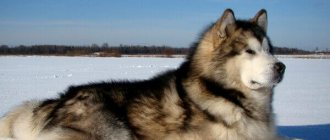History of the breed
Silver Ghost Cop
The breeding of the Weimar dog with its unsurpassed working qualities began in the Duchy of Saxe-Weimar in eastern Germany. According to legend, these amazing dogs with an excellent sense of smell were brought by Louis IX, nicknamed the Saint, and they came to the country after the Crusade of 1254.
It is believed that the Weinmeyer dog breed originated from these long-legged, gray, graceful dogs, which immediately won the love and recognition of the nobility. At first, only persons related to the king were allowed to breed them, and then to their close associates.
There is another version, according to which the Weimaraner is a dog that descended from the Bracco hunting breed, which was widespread in European territory. They were distinguished by the unsurpassed qualities of bloodhounds, the ability to follow the scent of prey, which is very much valued by hunters.
In the first half of the 19th century, the name of the Weimar cop breed was assigned to them, and breed standards were determined. Previously, both smooth-haired and long-haired Weimaraners were classified as German hounds.
Since 1896, the weimaraner began to take part in dog shows. Hunters from other countries began to pay attention to his working qualities. But becoming the owner of this beauty was not so easy. The gray dog could only belong to people who were members of a hunting club in Germany.
Only at the beginning of the twentieth century, an American citizen managed to become a member of this club, acquire ownership of several amazing gray dogs with blue eyes, take them to his homeland, where he began breeding and promoting them.
For reference! In the fifties of the last century, a real boom in this gray beauty began. Not only hunters, but also simply animal lovers wanted to buy it to keep them in apartments and their own houses as pets.
Weinmeyer breed standard
Interesting Facts
During the existence of the Weimaraner, many amazing facts have accumulated in the history of the breed:
- The first German Weimaraner Hunting Club was founded in 1897. For a long time, only representatives of the local aristocracy could become owners of these dogs.
- The graceful and artistic Weimar cops often appeared in films, commercials and music album covers. They can be seen in such films as “Daylight” and “Show Winners.”
- Weimar cops won the hearts of many famous people. Among the owners of dogs of this breed are such celebrities as President Eisenhower and Hollywood actress Grace Kelly.
- The most famous Weimaraner named Man Ray belonged to photographer William Wegman. Having accidentally entered the frame, the dog surprised the photographer with the human expression on his face and for a long time became the main subject of photo and video filming. In 1988, Wegman's Weimar cops participated in the famous international children's program Sesame Street, in which they added letters and taught the younger generation to count from 1 to 9.
Description of the breed
First of all, the Weinminer dog has a beautiful, harmoniously built body. Along with her persistent, strong character, she lacks aggressiveness and is easy to control.
Description of the Weimaraner breed:
- skull - flat, wide, muzzle - elongated;
- nose - slightly protruding beyond the lower jaw, has a dark or gray lobe;
- jaw - strong with a scissor bite;
- eyes - slightly slanted, small, bluish in color at an early age, becoming amber in color as the dog grows older;
- ears - high set, hanging, slightly rounded at the bottom;
- paws - dry, high, strong, with well-developed muscles.
The Weinmeyer is a medium-sized dog with a proportional build. The height of a male dog at the withers is 60-70 centimeters and weighs 30-40 kilograms. Bitches are slightly shorter, their height barely reaches 65 centimeters, and their weight is no more than 35 kilograms.
Weinmeyer in the rack
Dalmatian
Known for its white coat with black spots and slender posture, the Dalmatian is a medium to large sized dog with a muscular build and athletic disposition. Their energy makes these graceful dogs ideal companions for avid outdoor enthusiasts , while their loyalty and alertness make them excellent guard dogs. Dalmatians have brown and blue eyes, although the latter are less common.
Did you know that the Dalmatian is the mascot of American fire departments?
Features of character and behavior
The breed is completely non-aggressive towards people and is endlessly devoted to its owner. The dog is easy to train and quickly learns commands. She can be flexible and gentle, it all depends on the mood of the Weimaraner, now she loves everyone, but after a while the expression on her face changes, and she no longer wants to see anyone around.
The dog's characteristics do not allow him to shout at him or raise his voice. A sensitive dog remembers grievances well and remembers them for a long time.
And although Weimaraners are taken as pets, we should not forget that this is still a hunting dog that needs a lot of exercise. Therefore, the best place for her would be a country house, where she can run around to her heart's content.
Important! You need to walk your dog 3 times a day for at least an hour. And you don’t just stand still, breathe the air, you have to run, jump, overcome obstacles, and ride a bike with it.
A poorly walked Weimaraner dog can destroy everything in the apartment, chew furniture and shoes of the owners, open the window and go for an independent walk.
Dog on a walk
Feeding
When composing your pet’s diet, take into account its level of activity and activities. If the dog is hunting, it will need a higher calorie diet.
Calculation of portions depends on the age, weight, and health status of the animal. For dry food, manufacturers set recommended portions. As for natural food, 1 kg per day is enough for puppies, 2 or 2.5 kg per day for an adult dog. The daily norm is divided by the number of feedings, depending on age.
Dry food should be chosen super-premium or holistic.
The basis of natural nutrition should be meat and meat products - 50%. The remaining half should consist of cereals, vegetables, dairy products, and eggs.
Prohibited:
- tubular bones;
- chocolate and sweets;
- raisins and grapes;
- onion and garlic.
- wheat, corn, soybeans;
- White rice.
Photo: pixabay.com
Advantages and disadvantages
The Weimar Pointer is very dependent on its owner. This is an immensely loyal dog that absolutely cannot stand loneliness. She will accompany her owner everywhere he goes: to the kitchen, bedroom, bathroom, yard, and will follow him on the way to work.
On the one hand, such devotion is a plus of the breed, on the other hand, it is a big minus. Since it is absolutely impossible to leave a dog alone in the house. She begins to get bored, whine, howl, and it takes a lot of work to wean her off of this. In this case, it is better to have two pets of this breed at once.
The advantage of a Weimaraner dog is that it easily adapts to life in a new family if family members treat it well. With proper attention, she quickly begins to feel like she belongs in her new home and does not miss her old home.
Sad blue-eyed dog
TOP nicknames
When choosing a name for a Weimar pointer, you can emphasize the rarity and aristocracy of the breed. You can rely on an attractive appearance and exclusive color, or highlight the similarity of your pet’s habits with movie or pop stars.
For example, nicknames for a “boy” Weimaraner:
- Hunter;
- Leo;
- Gray;
- Bruno;
- Willie;
- Wagner;
- Storm;
- Gabriel;
- Dream;
- Boss.
Nicknames for “girl” Weimaraners:
- Greta;
- Kara;
- Irma;
- Sheila;
- Patty;
- Nika;
- Dolly;
- Elsa;
- Hanni;
- Jesse.
The dog's name should not be consonant with commands, human names common in your region, or carry a negative semantic connotation.
Color variations and appearance
Shorthaired Weimaraners have a fairly thick coat that lies close to the skin, with little or no undercoat. Dogs born with long hair were initially culled.
It was only after the 1935 international dog show in Germany, which featured dogs of varying coat lengths, that the long-haired breeds were recognized by the FCI (Federation Cynologique Internationale) and allowed to breed, but they are still rarely seen. Mostly shaggy Weinmeiers are common in Germany, Australia and England. In the United States of America, long-haired dogs have never gained recognition.
Long-haired representative of the breed
Wool
Long-haired dogs have very soft, silky hair up to 5 centimeters in size. The long, slightly wavy coat is unevenly distributed over the body. It mainly predominates in the abdomen, chest, lower neck, and on the back of the front legs.
The longest hair is on the tail. On the ears it alternates with a short one, thereby forming a kind of fringe. The presence of a soft undercoat is not necessary; it may or may not be present.
Color
There are officially recognized 2 dog coat colors: mouse, silver-gray and their shades. But this only applies to the gray color of the breed. In addition to these colors, there are black, brown, and blue Weimaraners.
Note! A small number of white spots present on the dog’s paws and chest are not a breed defect.
Weimaraner Appearance Standard
Weimaraners are beautiful, strong dogs with a muscular yet elegant and graceful build. They look fit and athletic, swim well, and run fast. Distinctive features of appearance: large size, regal posture, smooth shiny coat of unusual color, wide hanging ears, expressive eyes.
The height of the Weimaraner is above average, males reach 70 cm, females - 65 cm. The weight of these dogs is 25-35 kg, males can weigh more, but this is not desirable.
Head
The head is proportional to the body and has a wedge-shaped shape. The skull is slightly convex, the occipital protuberance is poorly defined. The forehead is flat, divided by a furrow, the stop is smooth. The bridge of the nose is straight, the lobe is large and protruding. Colored flesh-colored, brownish or grayish.
The muzzle is long, almost rectangular. The lips are dry, the upper one hangs down a little and overlaps the lower one. Forms a small fold at the corners of the mouth. The jaws are strong, cheekbones with well-defined muscles. Scissor bite.
The Weimaraner's eyes are small, round, and slightly slanted. Puppies are blue, adult dogs are amber - light or dark. The eyelids fit tightly and are colored to match the color of the coat. The look is smart, attentive. The ears are wide, long, and have rounded tips. Set high, hanging down to the lower jaw. If the dog is alert, he lifts the bases of his ears and turns them forward.
Frame
The body is harmoniously built, rectangular in format. The neck is gracefully arched, muscular, smoothly blending into well-defined withers. The back is straight, wide, the croup is moderately sloping. The chest is deep, reaching to the elbows, the belly is only slightly tucked.
The tail is strong, long, and set low. Thick at the base, tapering towards the tip. In a calm state it is lowered down. An excited dog lifts it, sometimes bends it with a hook. Among hunters, it is customary to dock the tail at half its length.
Limbs
The limbs are long, sinewy, with clearly defined muscles. The front ones are not set wide, parallel. The shoulders are muscular, long, elbows point back. The hind legs are straight, with strong bones. The thighs are strong and provide good propulsion when running, and the hocks are well defined.
The paws are oval, the toes are compressed into a ball. The peculiarity of the representatives of the breed is that the middle finger is longer than the others. The pads are hard, the claws are thick and gray. The dog moves sweepingly, smoothly, running with long buckles. When moving, the back remains straight and the limbs are parallel.
Coat and colors
There are two varieties of Weimaraners: long-haired and short-haired. The first has silky, soft fur, 3-5 cm long. It can be slightly wavy or straight. Longer on the ears, neck, chest, and stomach. There are featherings on the legs and tail. Such dogs are not recognized by the American Quesnel Club.
Shorthaired Weimaraners have a smooth, shiny coat that lies close to the body. The outer hair is dense, thick and hard. In both varieties the undercoat is weakly expressed, sparse or absent at all.
The Weimaraner can have one of 3 colors:
- light gray;
- silver gray;
- dark grey.
There may be a slight copper tint present. The hair on the head is lighter. There may be small white marks on the fingers and chest. There should be no brown or other colored spots.
Photos complement the description of the exterior:
Disqualifying faults
The breed standard clearly defines what the appearance of these dogs should be. Although it has changed several times, in 2009 the longhaired variety was recognized. At the same time, blue Weimaraners were no longer disqualified.
To preserve breed characteristics, crossing these dogs with other pointers is not allowed. If there are deviations from the standard, the dogs are disqualified. They can be removed from exhibitions and breeding due to the following shortcomings:
- hunchback or sagging back;
- height above or below standard by more than 2 cm;
- narrow pointed muzzle;
- pronounced jowls;
- short or narrow ears;
- pendant around the neck;
- barrel chest;
- strongly tucked belly;
- the coat is fluffy, with long-haired individuals having curls;
- yellow, brown, black or black color, presence of spots or tans.
Similar breeds
There are several dog breeds similar to the Weimaraner. They are also hunting dogs and have similar temperament and working qualities. But knowing the characteristic features of their appearance, it is easy to distinguish them:
- the Hungarian Vizsla is similar in size and body structure, it has the same coat, but is golden-red or brown in color;
- The shorthaired pointer is not such a muscular and large dog, the color is uneven, with spots;
- The Silver Labrador is a mixed breed obtained from crossing with a Weimaraner; it has a more powerful body, shorter paws, and pointed ears.
In the photo there is a Hungarian Vizsla:
Kurzhaar:
Silver Labrador:
Attitude towards children
Dogs of this breed are good watchdogs. They always bark to warn of the approach of a stranger, and will never offend either the owner himself or members of his family. In order for a dog to get along well with children, it needs early socialization.
Despite the fact that the Weimaraner dog has a kind character, the appearance of children in the house who will pull at its paws, tail and ears will not please you. Of course, she won’t bite anyone to death, but she won’t give herself offense either.
Photo review
Photos of Weimaraner puppies and dogs perfectly convey the main traits of the breed: speed, energy and determination. These graceful hunters fit well into expensive interiors, but are at their best on rough terrain.
Attitude towards pets
Friendly relationships with pets are possible if they grow up together and know each other from an early age. When keeping several dogs in one family at once, the Weimaraner accepts only the dogs of its pack.
Relationships with dogs running past may not be friendly at all. On a walk or at the dog park, dogs of this breed establish excellent relationships with other brothers if they are first introduced to each other.
Friendly family
Alaskan Klee Kai
Klee Kais are similar to Huskies, but much smaller in size:
- toy – up to 34 cm;
- mini – up to 38 cm;
- standard – up to 43 cm.
The breed has appeared recently, but a standard has already been developed for it in the AKC. Typical colors of Alaskan Klee Kais are a combination of white with black, gray, and brown. Any eye color is allowed.
Care and maintenance
For keeping a silver ghost dog, its own home with a spacious fenced area is more suitable, where it can satisfy its need for high physical activity.
Attention! Limited movement, coupled with the willfulness inherent in this breed of dog, can make your pet an unhappy animal. The Weimaraner's character will begin to deteriorate sharply; he will stop obeying and refuse to follow learned commands.
You can keep your pet in an enclosure only during the warm season. In cold weather it must be transferred to a warm room. His wool does not provide adequate warmth for living outside in the cold. In an apartment, a dog can only be kept by a person who has a lot of free time for long walks in the fresh air.
Brushing, bathing
This dog breed is not difficult to care for. Shedding occurs once a year, as does all dogs, except those that have no hair at all. Their coat does not have a specific dog smell, which is important for apartment living.
The dog does not require frequent washing. Wash it as it gets dirty, maybe once every six months with special dog shampoos. Frequent bathing washes away the natural lubricant from the coat, the skin becomes dry, irritated, and begins to itch.
It is enough to brush the Weimaraner once a week with a comb or a glove with rubber spikes. Once a week you should pay attention to cleaning your ears and teeth. The eyes are washed with chamomile infusion as they sour. A dog's overgrown claws, if they do not wear down naturally during walks, are trimmed with special clippers.
Training and education
The Weimar Pointer is easy to train. This smart dog loves training and easily remembers commands for the rest of its life. It usually takes only 3 weeks to learn all the commands, even for a six-month-old puppy.
Dogs make excellent athletes; in cani-cross they have no equal in speed. For sporting competitions, the tallest individuals are chosen.
For reference! Their hunting qualities are incomparable. This is a versatile hunter that can work in any terrain, on land and in water, before and after the shot.
Dog while overcoming obstacles
General characteristics of the Weimaraner
The Weimaraner is a versatile hunting dog. It was bred in the 19th century in the German province of Weimar, for which it received its name. Among fanciers, the dog was nicknamed the “silver ghost” because of the unusual color of its coat, as well as its ability to silently track prey and run like a cat.
Among other cops, the Weimaraner stands out for its aristocratic appearance. Due to the unusual eye color and beautiful silver coat, this dog is immediately noticed. She is graceful, fast, resilient, and passionate. It was bred to hunt big game. Now representatives of this breed have become devoted and obedient companions. Thanks to their sensitive sense of smell, they are used in search and rescue work. Sometimes they guard the territory, although due to the lack of aggression they are not a good guard.
| Options | Characteristic |
| breed name | Weimaraner or Weimar pointer (German: weimaraner) |
| a country | Germany |
| time | 19th century |
| application | hunting dog, companion |
| group of breeds according to the ICF classification | cops, section continental cops |
| life expectancy | 10-13 years |
| height | males 59-70 cm, females 57-65 cm |
| weight | males 30-40 kg, females 25-35 kg |
| aggression | almost not |
| activity | very high |
| attitude towards a person | friendly, sociable, loves children, suspicious of strangers |
| intelligence | smart, easy to train |
| difficulty of care | simple, the coat hardly sheds |
pros
Weimaraners are friendly, cheerful dogs. They are created for hunting, but with proper upbringing and sufficient physical activity they can become a good companion for tourists and athletes. Representatives of the breed have the following advantages:
- balanced character;
- beautiful appearance;
- strongly attached to the owner and family members, affectionate;
- friendly to children, love to play with them, patient, treat them with care;
- not aggressive;
- do not enter into conflicts with other dogs;
- clean, unpretentious, do not require serious care;
- smart, quick-witted, quickly learn new things;
- athletic, agile.
Minuses
The Weimaraner is a large dog; he will feel uncomfortable in a city apartment. Homebodies, elderly people, those who are often away from home, and those new to dog breeding should not get this breed. Weimaraners require constant attention and need special training. They have a few more disadvantages:
- cannot stand loneliness, bark out of boredom, and chew things;
- can run away;
- small animals are perceived as game to be hunted;
- they require great physical activity;
- They can be stubborn and self-willed.
The video complements the characteristics of the breed:
Video: Weimaraner. Pros and cons of the breed
Video: Weimaraner in 4 minutes. Nothing extra.
Life expectancy and major diseases
In general, Weimaraners have good immunity and are not susceptible to frequent diseases. But like any dog, they have hereditary diseases. First of all, problems with the gastrointestinal tract. They often experience intestinal volvulus and stomach twisting, which are accompanied by pain and vomiting.
Note! If timely assistance is not provided, the outcome can be fatal.
Dogs of this breed can suffer from cancer:
- histiocytosis, which manifests itself as ulcers and nodular seals on the skin with metastases in the lungs;
- sarcoma of the mammary glands with metastases in all parts of the body.
A sharp loss of fur, scales and roughness of the skin indicate disorders of the endocrine system, in particular a malfunction of the thyroid gland. The disease is accompanied by poor appetite, a decrease or increase in body weight, apathy, sometimes vomiting and even fainting.
Cloudiness of the lens due to cataracts can lead to blindness. Corneal dystrophy contributes to visual impairment, and iris erosion leads to pain and watery eyes.
The life expectancy of a cop with proper care is 12-15 years.
Health
The Weimar Pointer can live about 10-13 years. But in order for the pet to live to this age, being beautiful and healthy, the owner must periodically show it to the veterinarian for a preventive examination and tests. It is also necessary to vaccinate the dog and carry out treatment against parasites and deworming.
In order to detect the disease in time, you need to know what health problems the Weimaraner breed is predisposed to:
- Demodicosis is an invasive disease caused by a microscopic mite.
- Bloating - intestinal volvulus occurs due to improper nutrition; a dog can die from bloating within a few hours.
- Cryptorchidism - occurs in male dogs, the pathology leads to infertility.
- Mastocytoma is a cancer cell disease.
- Hip dysplasia - can lead to immobility and causes severe pain to the dog.
- Myasthenia gravis is a disorder of neuromuscular transmission, most often observed in adult animals after one year.
- Pododermatitis is interdigital dermatitis.
- Entropion - entropion of the eyelid cannot be treated and requires surgical intervention.
- Corneal dystrophy is a group of non-inflammatory hereditary diseases that reduce the transparency of the cornea of the eye.
- Degenerative myelopathy is a severe progressive neurodegenerative disease that leads to paralysis of the hind limbs.
- Fibrosarcoma is a malignant tumor that develops from cutaneous or subcutaneous fibroblasts.
Vaccinations
When a puppy is weaned from its mother, it stops receiving the initial immunity that was passed on to it through its mother's milk. In the first year of a baby’s life, all of his internal organs and systems develop, and his health improves.
During this period, he needs help in maintaining a good immune system, which will determine the strength of his health for the rest of his life. Timely vaccination provides significant assistance in this regard.
The first vaccination is carried out at the age of 2-3 months. The formation of immunity and susceptibility to many diseases largely depend on it. A comprehensive vaccination provides protection against several diseases that most often affect Weimaraner puppies.
These are plague, viral hepatitis, enteritis, a group of infectious agents called adenoviruses, and the infectious disease leptospirosis. After 3 weeks, the complex vaccination is repeated, which includes vaccination against rabies.
After 10 days, when the vaccinated puppy develops antibodies to pathogens, it can be taken out for a walk. Further, vaccination against infections is carried out regularly once a year. You should visit a veterinarian once every 6 months and a week before scheduled vaccination.
Healthy babies
How much does a dog cost?
The price for a Weimar pointer puppy with a pedigree ranges from 35 to 65 thousand rubles. Puppies from champion parents or from outstanding representatives of the breed brought from abroad will be even higher.
This is not a breed that comes cheap.
If they only ask for a few thousand for a puppy, you can be sure that you are purchasing a mixed breed. This is the best case scenario. At worst, the mestizo will also end up sick.
Of course, there are exceptions when, for some reason, a good breeder is forced to sell babies cheaper. In this case, you need to take advantage of the chance, realizing that you are very lucky.
How is pregnancy going?
Although the first estrus in females occurs at the age of 6-9 months, she is not yet ready to bear offspring. Mating can be carried out only with the onset of the third heat, which on average lasts from 2 weeks to a month every six months.
Mating
The most favorable days for mating are considered to be 9-14 days from the start of estrus. During this period, the dog becomes very excited. There are some mating rules that should be followed.
- Before you start mating, you need to take your pet for a good walk.
- Usually the female is brought to the male's territory, but neutral territory is also acceptable.
- The process itself takes several minutes, but crossing, during which the male’s seed enters the female’s uterus through the genital tract, lasts 20 minutes. Therefore, separation of partners immediately after mating can negatively affect fertilization.
Pregnancy
The Weimaraner female's pregnancy lasts 60-70 days. At this time, there is a heavy load on all the internal organs of the dog. The pet should be protected from heavy stress, not allowed to worry, and protected from all kinds of noise.
Attention! If the bitch starts bleeding or refuses to eat, you should immediately call a veterinarian.
Minor mucous discharge in the second half of pregnancy is considered normal. An abundance of yellow or greenish discharge indicates that the time for childbirth is approaching. At this time, the expectant mother refuses to eat, whines, and drinks a lot.
How to choose a puppy
The Weimaraner is a rather rare breed of dog, and when purchased through advertisements, they may sell you a mestizo instead of a purebred dog. Therefore, you should only buy from trusted breeders with a good reputation. In addition, deviations in the standard will forever block the pet’s path to the exhibition area.
Before buying a puppy, you need to pay attention to its appearance. His coat should be silky, uniform, without bald spots or rashes on the skin.
The puppy should not have an unpleasant odor. There should be no bumps on the ribs, which indicate the early stage of rickets. There should be no inguinal or umbilical hernias on the abdomen. The puppy should also be active, moderately well-fed, and not cower in corners out of fear.
Active puppies
Australian Shepherd
This charming member of the herding group is a particularly popular breed of merle dog with green, blue, brown eyes or heterochromia. Australian Shepherds have a medium-length and somewhat coarse coat, they have a short-cropped tail and an agile, muscular build. All this creates a truly striking appearance, and the alert and courageous nature makes Australian Shepherds excellent herders in different climatic conditions.
Did you know that originally bred as hard-working herding dogs, today's Australian Shepherds are often used as police dogs to detect drugs or assist in search and rescue missions, as well as service dogs that help people with disabilities.











